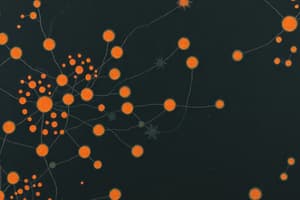Podcast
Questions and Answers
What is the primary focus of metagenomics?
What is the primary focus of metagenomics?
- The structure and function of nucleotide sequences from all organisms in a bulk sample (correct)
- The genetic analysis of a single organism
- The analysis of only eukaryotic organisms in an environment
- The study of a specific nucleotide sequence from cultured microorganisms
Which of the following best describes the application areas of metagenomics?
Which of the following best describes the application areas of metagenomics?
- Analyzing the composition of microbial communities in various environments (correct)
- Examining genetic diseases in humans through genomic epidemiology
- Evaluating chromosomal abnormalities in cultured cells
- Studying the structures of proteins in a single species
Which of the following is NOT typically a focus of metagenomics studies?
Which of the following is NOT typically a focus of metagenomics studies?
- Gene expression of cultured organisms (correct)
- Nucleotide sequences from uncultured microorganisms
- Functional analysis of microbial community interactions
- Diversity of microbial genomes in a sample
What advantage does metagenomics have over traditional microbiological methods?
What advantage does metagenomics have over traditional microbiological methods?
Which of the following fields is least likely to utilize metagenomics?
Which of the following fields is least likely to utilize metagenomics?
Which sampling strategy ensures that specific subgroups within a population are sampled?
Which sampling strategy ensures that specific subgroups within a population are sampled?
What is the purpose of using tools like Trimmomatic in data analysis?
What is the purpose of using tools like Trimmomatic in data analysis?
Which bioinformatics tool is primarily used for analyzing amplicon sequencing data?
Which bioinformatics tool is primarily used for analyzing amplicon sequencing data?
What does the Shannon index measure in microbial diversity assessment?
What does the Shannon index measure in microbial diversity assessment?
What is the primary function of metagenomic libraries?
What is the primary function of metagenomic libraries?
Which method is used to estimate α and β diversity in microbial communities?
Which method is used to estimate α and β diversity in microbial communities?
Which high-throughput sequencing platform is known for its long reads, suitable for complex genomes?
Which high-throughput sequencing platform is known for its long reads, suitable for complex genomes?
What role do statistical tools like vegan and phyloseq play in bioinformatics?
What role do statistical tools like vegan and phyloseq play in bioinformatics?
Flashcards are hidden until you start studying
Study Notes
Metagenomics
- Metagenomics is the study of the complete DNA sequences from a community of microorganisms.
- Metagenomics often focuses on specific groups of organisms, for example, microbes found on skin, in soil or in water samples.
- Metagenomics allows for studying uncultured microorganisms, giving insights into diverse microbial communities.
Sample Collection Techniques
- Soil, water, sediment, and air are collected from various ecosystems to study microbial communities.
- Human samples from the gut, skin, oral cavity, and respiratory system are collected using swabs, biopsies, or stool samples.
- Sterile containers, immediate cooling, and freezing are used to preserve the viability of microbes during sample collection.
- Random, stratified, and systematic sampling strategies are used to ensure representative sampling.
Data Analysis Methods
- High-throughput sequencing platforms such as Illumina, PacBio, and Nanopore are used for generating vast amounts of microbial sequence data.
- Quality control steps include removing low-quality reads and contaminants using tools like FastQC and Trimmomatic.
- De novo assembly methods like MEGAHIT and SPAdes reconstruct genomes from metagenomic data.
- Alpha and beta diversity calculations are used to compare the composition and diversity of microbial communities.
Functional Metagenomics
- Environmental DNA is analyzed to identify and characterize functional genes.
- Genomic libraries are created from samples to find genes of interest.
- Functional screens using reporter genes or selection markers are employed to identify active genes.
- Functional metagenomics provides insights into metabolic pathways, antibiotic resistance mechanisms, and the discovery of natural products.
Microbial Diversity Assessment
- Shannon and Simpson indices are used to quantify microbial diversity.
- Richness refers to the number of species in a community, while evenness represents the distribution of species abundance.
- Phylogenetic trees are constructed to understand evolutionary relationships amongst microbes.
- Metacommunity structure investigates the influence of environmental factors on community composition and diversity.
Bioinformatics Tools
- QIIME and Uparse are used for analyzing amplicon sequencing data.
- KEGG, COG, and GO databases provide functional annotations for genes.
- R packages like vegan and phyloseq are used for community analysis and visualizations.
- Tools such as Ocean, iTOL, and Cytoscape are used for representing microbial diversity and functional relationships.
Studying That Suits You
Use AI to generate personalized quizzes and flashcards to suit your learning preferences.




